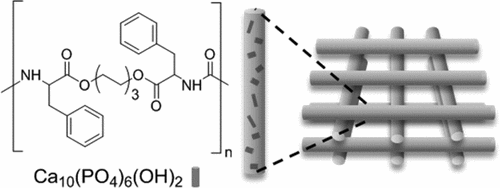当前位置:
X-MOL 学术
›
Biomacromolecules
›
论文详情
Our official English website, www.x-mol.net, welcomes your feedback! (Note: you will need to create a separate account there.)
Three-Dimensional Printing of Nano Hydroxyapatite/Poly(ester urea) Composite Scaffolds with Enhanced Bioactivity
Biomacromolecules ( IF 6.2 ) Pub Date : 2017-10-25 00:00:00 , DOI: 10.1021/acs.biomac.7b01222 Jiayi Yu 1 , Yanyi Xu 1 , Shan Li 1 , Gabrielle V. Seifert 1 , Matthew L. Becker 1
Biomacromolecules ( IF 6.2 ) Pub Date : 2017-10-25 00:00:00 , DOI: 10.1021/acs.biomac.7b01222 Jiayi Yu 1 , Yanyi Xu 1 , Shan Li 1 , Gabrielle V. Seifert 1 , Matthew L. Becker 1
Affiliation

|
Polymer–bioceramic composites incorporate the desirable properties of each material while mitigating the limiting characteristics of each component. 1,6-Hexanediol l-phenylalanine-based poly(ester urea) (PEU) blended with hydroxyapatite (HA) nanocrystals were three-dimensional (3D) printed into porous scaffolds (75% porosity) via fused deposition modeling and seeded with MC3T3-E1 preosteoblast cells in vitro to examine their bioactivity. The resulting 3D printed scaffolds exhibited a compressive modulus of ∼50 MPa after a 1-week incubation in PBS at 37 °C, cell viability >95%, and a composition-dependent enhancement of radio-contrast. The influence of HA on MC3T3-E1 proliferation and differentiation was measured using quantitative real-time polymerase chain reaction, immunohistochemistry and biochemical assays. After 4 weeks, alkaline phosphatase activity increased significantly for the 30% HA composite with values reaching 2.5-fold greater than the control. Bone sialoprotein showed approximately 880-fold higher expression and 15-fold higher expression of osteocalcin on the 30% HA composite compared to those of the control. Calcium quantification results demonstrated a 185-fold increase of calcium concentration in mineralized extracellular matrix deposition after 4 weeks of cell culture in samples with higher HA content. 3D printed HA-containing PEU composites promote bone regeneration and have the potential to be used in orthopedic applications.
中文翻译:

具有增强生物活性的纳米羟基磷灰石/聚(酯脲)复合支架的三维印刷
聚合物-生物陶瓷复合材料融合了每种材料的理想特性,同时减轻了每种组分的局限性。1,6-己二醇l通过融合沉积建模,将与羟基磷灰石(HA)纳米晶体混合的基于-苯丙氨酸的聚(酯脲)(PEU)三维(3D)打印到多孔支架(孔隙率75%)中,并在体外接种MC3T3-E1成骨细胞检查它们的生物活性。在PBS中于37°C孵育1周后,所得3D打印支架的压缩模量约为50 MPa,细胞生存力> 95%,放射线造影剂的组成依赖性增强。使用定量实时聚合酶链反应,免疫组化和生化测定法测量了HA对MC3T3-E1增殖和分化的影响。4周后,对于30%HA复合物,碱性磷酸酶活性显着增加,其值比对照高2.5倍。与对照组相比,在30%HA复合材料上,骨唾液蛋白的骨钙素表达高出约880倍,而骨钙蛋白的表达高出15倍。钙定量结果表明,在具有较高HA含量的样品中培养4周后,矿化的细胞外基质沉积中钙的浓度增加了185倍。3D打印的含HA的PEU复合材料可促进骨骼再生,并具有在骨科应用中的潜力。
更新日期:2017-10-25
中文翻译:

具有增强生物活性的纳米羟基磷灰石/聚(酯脲)复合支架的三维印刷
聚合物-生物陶瓷复合材料融合了每种材料的理想特性,同时减轻了每种组分的局限性。1,6-己二醇l通过融合沉积建模,将与羟基磷灰石(HA)纳米晶体混合的基于-苯丙氨酸的聚(酯脲)(PEU)三维(3D)打印到多孔支架(孔隙率75%)中,并在体外接种MC3T3-E1成骨细胞检查它们的生物活性。在PBS中于37°C孵育1周后,所得3D打印支架的压缩模量约为50 MPa,细胞生存力> 95%,放射线造影剂的组成依赖性增强。使用定量实时聚合酶链反应,免疫组化和生化测定法测量了HA对MC3T3-E1增殖和分化的影响。4周后,对于30%HA复合物,碱性磷酸酶活性显着增加,其值比对照高2.5倍。与对照组相比,在30%HA复合材料上,骨唾液蛋白的骨钙素表达高出约880倍,而骨钙蛋白的表达高出15倍。钙定量结果表明,在具有较高HA含量的样品中培养4周后,矿化的细胞外基质沉积中钙的浓度增加了185倍。3D打印的含HA的PEU复合材料可促进骨骼再生,并具有在骨科应用中的潜力。



























 京公网安备 11010802027423号
京公网安备 11010802027423号